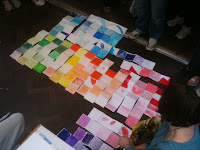Wednesday started with PE and we worked with instructors learning to ensure that all members of a class are able to participate in PE sessions. Our usual instructor has been drumming into us the idea that sport is for all from the very beginning of the course and it was great to see how sports that I have used in school before can be adapted in the smallest of ways so that children with a physical disability can enjoy the activities with the rest of their class without any fear of embarrassment.
The first game we played in my group was a child-friendly version of Boules known as Boccia, which uses bean-stuffed balls rather than metal ones for use indoors.
Boccia was originally designed for athletes with cerebral palsy and is one of the fastest growing international and Paralympic sports. Over 50 countries have local or national competitive programs. The slight adjustment as far as we were concerned to the regular rules of Boules that made this game inclusive was merely that all players had to be sat down to take their go. It could almost seem crazy that the slightest of changes suddenly makes this game available to players with mobility issues, but if we are honest, how many of us would have thought of making that adjustment without prompting? The game became incredibly competitive and I don't think anyone objected to sitting down to take their go, so it would not have caused any embarrassment for a player that had to sit down.
I originally learned about Boccia first hand from an athlete that represents Great Britain in the sport internationally. A friend from university, he was studying sport management to my event management and we had a number of lectures that overlapped. If you would like to read about his story, you can find out more here: Ali Lalani.
After Boccia, we then tried a game that I have played with children on many occasions and continue to love: New Age Kurling! I already know that this game allows children that perhaps might usually struggle in PE to shine (with one girl in my year six class becoming school champ, much to the entire teaching staff's delight!), but again, by adding a rule that all players had to be sat down, the game suddenly became inclusive. The instructors also explained how players with quite severe mobility issues have previously been able to enjoy the game by using noses, adapted caps and all sorts of other methods to send their Kurling stones.
The next activity that we got to try, an opportunity that we were very privilaged to experience, was wheelchair basketball. Not only was this tremendously good fun, but it opened a dialogue regarding how we could potentially include wheelchair users into PE activities rather than restricting them to measuring/marking/judging roles. We discussed how during athletics, you can do challenges involving wheelchairs, like how far can the children go on one push of the wheels. If you have access to another wheelchair, there is nothing to stop the whole class taking part in this activity. It is likely that the wheelchair user would excel against their classmates, so not only would they be included, they would be empowered by their success too. Something interesting to think about definitely...
Then we had Art and a session on sculpture. The great thing about sculpture is that it is all inclusive. Yes it can be about an accurate representation of something, but more commonly, it is about expression, exploration and interpretation. Take the work of Antony Gormley:
 |
| Antony Gormley is arguably most commonly known for his Angel of the North. |
In a career spanning nearly 40 years, Antony Gormley has made sculpture that explores the relation of the human body to space at large, explicitly in large-scale installations like Another Place, Domain Field and Inside Australia and implicitly in works such as Clearing, Breathing Room and Blind Light, where the work becomes a frame through which the viewer becomes the viewed. By using his own existence as a test ground, Gormley's work transforms a site of subjective experience into one of collective projection. Increasingly, the artist has taken his practice beyond the gallery, engaging the public in active participation, as in Clay and the Collective Body in Helsinki and the acclaimed One & Other in London's Trafalgar Square.
While some of Gormley's work is clearly inspired by people and the human form, not one of the pictures I have posted are an accurate representation of a person. They are Gormley's interpretation of the human form - his expression.
Like I discussed in my post regarding colour in art, children need to feel to use art for a time for expression and this includes all children. Within art, it is perhaps children with degrees of sight impairment that could perhaps find themselves excluded from mainstream activities and if one allows oneself to think realistically about things, should this be the case? Monet went blind during a cataract operation whilst painting his Waterlilies and still managed to finish them!
Blind children can and should participate in art activities. Adapting the material and focus to highlight their abilities is key for their enjoyment. Teachers should offer material that stimulates their other senses such as touch, smell and hearing to create collages, sculptures and portraits. Some children like to explain their thoughts on their projects; others simply want to play with the supplies. Either way, giving blind children an equal opportunity to express themselves is important for their development.
And finally, my sculpture: Our brief was a gargoyle and what can I say, I am a classicist... ;)















